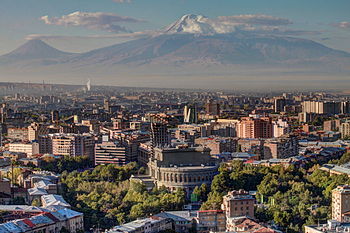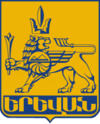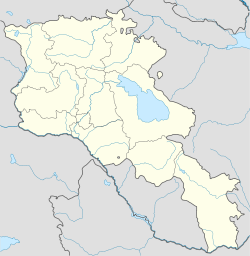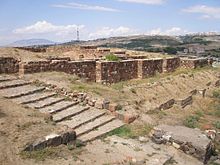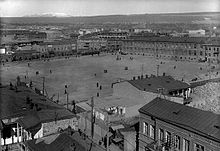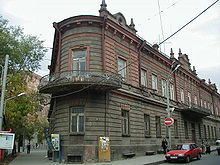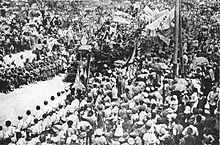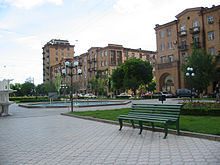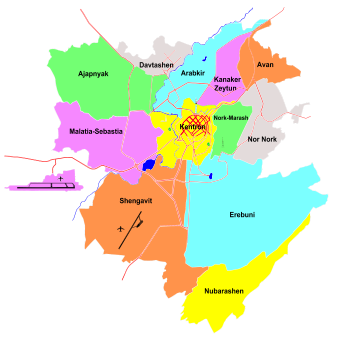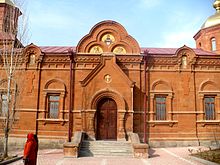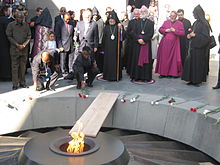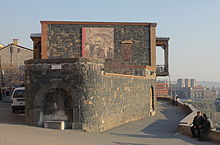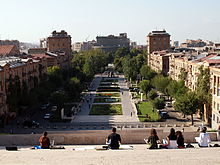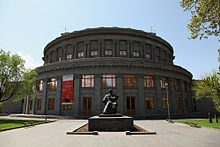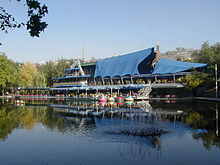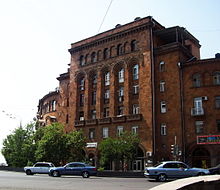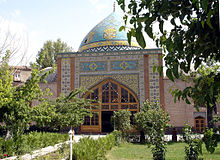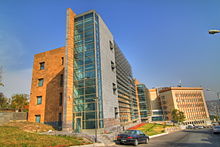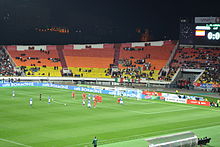
Yerevan
About this schools Wikipedia selection
This content from Wikipedia has been selected by SOS Children for suitability in schools around the world. SOS Children works in 45 African countries; can you help a child in Africa?
Coordinates: 40°11′00″N 44°31′00″E
| Yerevan Երևան |
|||
|---|---|---|---|
| Yerevan skyline with Mount Ararat in the background | |||
|
|||
|
|
|||
| Coordinates: 40°11′N 44°31′E | |||
| Country | |||
| Established | 782 BC | ||
| City status | 1879 | ||
| Founder | Argishti I | ||
| Government | |||
| • Type | Mayor–Council | ||
| • Body | Yerevan City Council | ||
| • Mayor | Taron Margaryan | ||
| Area | |||
| • Total | 227 km2 (88 sq mi) | ||
| Elevation | 989.4 m (3,246.1 ft) | ||
| Population (2011) | |||
| • Total | 1,121,900 | ||
| • Density | 4,896/km2 (12,680/sq mi) | ||
| Time zone | GMT+4 ( UTC+4) | ||
| Area code(s) | +374 10 | ||
| Website | www.yerevan.am | ||
| Sources: Yerevan city area and population | |||
Yerevan ( Armenian: Երեւան or Երևան [jɛɾɛˈvɑn]) is the capital and largest city of Armenia and one of the world's oldest continuously inhabited cities. Situated along the Hrazdan River, Yerevan is the administrative, cultural, and industrial centre of the country. It has been the capital since 1918, the thirteenth in the history of Armenia.
The history of Yerevan dates back to the 8th century BC, with the founding of the fortress of Erebuni in 782 BC by king Argishti I at the western extreme of the Ararat plain. After World War I, Yerevan became the capital of the Democratic Republic of Armenia as thousands of survivors of the Armenian Genocide settled in the area. The city expanded rapidly during the 20th century as Armenia became one of the fifteen republics in the Soviet Union. In fifty years, Yerevan was transformed from a town of a few thousand residents within the Russian Empire, to Armenia's principal cultural, artistic, and industrial centre, as well as becoming the seat of national government.
With the growth of the economy of the country, Yerevan has been undergoing major transformation as many parts of the city have been the recipient of new construction since the early 2000s, and retail outlets such as restaurants, shops and street cafes, which were rare during Soviet times, have multiplied.
As of 2011 estimates, the population of Yerevan was 1,121,900 people making up to 34% of the total population of Armenia.
Yerevan was named the 2012 World Book Capital by UNESCO.
Etymology and symbols
One theory regarding the origin of Yerevan's name is the city was named after the Armenian king, Yervand IV (the Last), the last leader of the Orontid Dynasty, and founder of the city of Yervandashat. However, it is likely that the city's name is derived from the Urartian military fortress of Erebuni (Էրեբունի), which was founded on the territory of modern-day Yerevan in 782 BC by Argishti I. As elements of the Urartian language blended with that of the Armenian one, the name eventually evolved into Yerevan (Erebuni = Erevani = Erevan = Yerevan). Scholar Margarit Israelyan notes these changes when comparing inscriptions found on two cuneiform tablets at Erebuni:
The transcription of the second cuneiform bu [original emphasis] of the word was very essential in our interpretation as it is the Urartaean b that has been shifted to the Armenian v (b > v). The original writing of the inscription read «er-bu-ni»; therefore the prominent Armenianologist- orientalist Prof. G. A. Ghapantsian justly objected, remarking that the Urartu b changed to v at the beginning of the word (Biani > Van) or between two vowels (ebani > avan, Zabaha > Javakhk)....In other words b was placed between two vowels. The true pronunciation of the fortress-city was apparently Erebuny.

Early Christian Armenian chroniclers attributed the origin of the name, "Yerevan," to a derivation from an expression exclaimed by Noah, in Armenian. While looking in the direction of Yerevan, after the ark had landed on Mount Ararat and the flood waters had receded, Noah is believed to have exclaimed, "Yerevats!" ("it appeared!").
In Armenian manuscripts, Yerevan was also mentioned as Erevan, Erivan, Erewan, Ervan, Eruan, Arevan, Iravan, Revan and Ayravan.
However, the predominant former names of the city are Erebuni and Erevan.
The principal symbol of Yerevan is Mount Ararat, which is visible from any area in the capital. The seal of the city is a crowned lion on a pedestal with the inscription "Yerevan." The lion's head is turned backwards while it holds a scepter using the right front leg, the attribute of power and royalty. The symbol of eternity is on the breast of the lion with a picture of Ararat in the upper part. The emblem is a rectangular shield with a blue border.
On 27 September 2004, Yerevan adopted an anthem, "Erebuni-Yerevan", written by Paruyr Sevak and composed by Edgar Hovhanisyan. It was selected in a competition for a new anthem and new flag that would best represent the city. The chosen flag has a white background with the city's seal in the middle, surrounded by twelve small red triangles that symbolize the twelve historic capitals of Armenia. The flag includes the three colours of the Armenian National flag. The lion is portrayed on the orange background with blue edging.
History
Early history
The ancient kingdom of Van (Ararat or Urartu or Biainili), was formed in the 9th century BC in the basin of Lake Van of the Armenian Highland, including the territory of modern-day Yerevan. King Arame was the founder of the state which was one of the most developed states of its age.
However, the territory of Yerevan-Erebuni was settled in the fourth millennium B.C., fortified settlements from the Bronze Age include Shengavit, Tsitsernakaberd, Teishebaini, Arin Berd, Karmir Berd and Berdadzor. Archaeological evidence, such as a cuneiform inscription, indicates that the Urartian military fortress of Erebuni (Էրեբունի) was founded in 782 BC (29 years earlier than Rome) by the orders of King Argishti I at the site of current-day Yerevan, to serve as a fort and citadel guarding against attacks from the north Caucasus. Yerevan, as mentioned, is one of the most ancient cities in the world.
The cuneiform inscription found at Erebuni Fortress reads:
By the greatness of the God Khaldi, Argishti, son of Menua, built this mighty stronghold and proclaimed it Erebuni for the glory of Biainili [Urartu] and to instill fear among the king's enemies. Argishti says, "The land was a desert, before the great works I accomplished upon it. By the greatness of Khaldi, Argishti, son of Menua, is a mighty king, king of Biainili, and ruler of Tushpa." [ Van].
Between the sixth and fourth centuries BC, Yerevan was one of the main centers of the Armenian satrapy of the Achaemenid Empire. During the height of Urartian power, irrigation canals and an artificial reservoir were built on Yerevan's territory. In 585 BC, the fortress of Teishebaini (Karmir Blur), thirty miles to the north of Yerevan, was destroyed by an alliance of Medes and the Scythians.
Due to the absence of historical data, the timespan between the fourth century BC and the third century AD is known as the "Yerevan Dark Ages."
Armenia became a Christian nation in 301. The first church in Yerevan; the church of St. Peter and Paul, was built in the fifth century, and was demolished in 1931 to build a cinema hall. The Tsiranavor Surb Hovhannes Church of Avan (595–602) of Avan district which was partly damaged in the 1679 earthquake, is the city's oldest surviving church.
Arab, Persian and Ottoman rule
In 658 AD, Yerevan was conquered, during the height of Arab invasions. Since then, and as a result of the Arab trade activities, the site has been strategically important as a crossroads for the Arab caravan routes passing between Europe and India through lands controlled by the Arabs. It has been known as "Yerevan" since at least the seventh century AD. Between the ninth and eleventh centuries, Yerevan was a secure part of the Armenian Bagratuni Kingdom, before being overrun by Seljuks. The city was seized and pillaged by Tamerlane in 1387 and subsequently became an administrative centre of the Ilkhanate. Due to its strategic significance, Yerevan was constantly fought over, and passed back and forth, between the dominion of Persia and the Ottomans.
At the height of the Turkish-Persian wars, Yerevan changed hands fourteen times between 1513 and 1737. In 1604, under the order of Shah Abbas I, tens of thousands of Armenians including citizens from Yerevan were deported to Persia. As a consequence, population became 80 percent Muslim (Persians, Turco, Kurds) and 20 percent Armenian. Muslims were either sedentary, semi-sedentary, or nomadic. Armenians lived in Erevan or the villages. The Armenians dominated the various professions and trade in the area and were of great economic significance to the Persian administration. The Ottomans, Safavids, and Ilkhanids, all maintained a mint in Yerevan. During the 1670s, the Frenchman Jean Chardin visited Yerevan and gave a description of the city in his Travels of Cavalier Chardin in Transcaucasia in 1672–1673. On 7 June 1679, a devastating earthquake razed the city to the ground. During the Safavid Dynasty rule, Yerevan and adjacent territories were part of the Čoḵūr Saʿd administrative territory. This lasted until 1828, when the region was incorporated into Russian Empire.
Russian rule
During the second Russian-Persian war, Yerevan was captured by Russian troops under general Ivan Paskevich on 1 October 1827. It was formally ceded by the Persians in 1828, following the Treaty of Turkmenchay. Tsarist Russia sponsored Armenian resettlement from Persia and Turkey. Due to the resettlement, Armenians' share in city population increased from 28% to 53.8%. The resettlement was intended to create Russian power bridgehead in the Middle East. In 1829, Armenian repatriates from Persia were resettled in the city and a new quarter was built.
Yerevan has served as the seat of the newly-formed Armenian Oblast between 1828–1840. By the time of Nicholas I's visit in 1837, Yerevan had become an uyezd. In 1840, the Armenian Oblast was dissolved and its territory incorporated into a larger new province; the Georgia-Imeretia Governorate. In 1850 the territory of the former oblast was tuned into reorganized into the Erivan Governorate. Yerevan was the centre of the newly established governorate until 1917, when Erivan governorate was dissolved.
Yerevan began to grow economically and politically, with old buildings torn down and new buildings in European style erected instead. The first general plan of the city was made in 1854, during which, St. Hripsime and St. Gayane women's colleges were opened and the English Park was founded. In 1874, Zacharia Gevorkian opened Yerevan's first printing house and in 1879 the first theatre, sited near the church of St. Peter and Paul, was established.
At the beginning of the 20th century, Yerevan city's population was over 29,000, of which 49% were Azerbaijani Tatars, 48% Armenians and 2% Russians. In 1902, a railway line linked Yerevan with Alexandropol, Tiflis and Julfa, a railway line linked Yerevan with Alexandropol, Tiflis and Julfa. In the same year, Yerevan's first public library was opened. In 1905, the grandnephew of Napoleon I; prince Louis Joseph Jérôme Napoléon (1864–1932) was appointed as governor of Erivan province.
In 1913, for the first time in the city, a telephone line with eighty subscribers became operational.
Brief independence
At the start of the 20th century, Yerevan was a small town with a population of 30,000. In 1917, the Russian Empire ended with the October Revolution. In the aftermath, Armenian, Georgian and Muslim leaders of Transcaucasia united to form the Transcaucasian Federation and proclaimed Transcaucasia's secession.
The Federation, however, was short-lived and on 28 May 1918, the Dashnak leader Aram Manukian declared the independence of Armenia. Subsequently, Yerevan became the capital and the centre of the newly-independent Democratic Republic of Armenia, although the members of the Armenian National Council were yet to stay in Tiflis until their arrival in Yerevan to form the government in the summer of the same year.
On 26 May 1919, the government passed a law to open the Yerevan State University, which was situated on the main street of Yerevan, the Astafyan (now Abovyan) street.
However, after a short period of independence, Yerevan fell to the Bolshevik 11th Red Army who entered the city during the Russian Civil War on 29 November 1920, and Armenia was incorporated into the Soviet Union on 2 December 1920. Although nationalist forces managed to retake the city in February 1921 and successfully released all the political leaders, the city's nationalist elite were once again defeated by the Soviet forces on 2 April 1921.
Soviet era
Yerevan became the capital of the newly formed Armenian Soviet Socialist Republic, one of the fifteen republics of the Soviet Union. Yerevan was the first city in the Soviet Union for which a general plan was developed. The "General Plan of Yerevan", approved in 1924, was developed by the academician Alexander Tamanyan. The plan was designed for a population of 150,000.
During the Soviet era the city was transformed into a modern industrial metropolis of over a million people, to become a significant scientific and cultural centre.
Tamanian incorporated national traditions with contemporary urban construction. His design presented a radial-circular arrangement that overlaid the existing city and incorporated much of its existing street plan. As a result, many historic buildings were demolished, including churches, mosques, the Persian fortress, baths, bazaars and caravanserais. Many of the districts around central Yerevan were named after former Armenian communities that were destroyed by the Ottoman Turks during the Armenian Genocide. The districts of Arabkir, Malatia-Sebastia and Nork Marash, for example, were named after the towns Arabkir, Malatya, Sebastia, and Marash, respectively. After the end of World War II, German POWs were used to help in the construction of new buildings and structures, such as the Kievyan Bridge.
In 1965, during the commemorations of the fiftieth anniversary of the Armenian Genocide, Yerevan was the location of a demonstration, the first such demonstration in the Soviet Union, to demand recognition of the Genocide by the Soviet authorities. In 1968, the city's 2,750th anniversary was commemorated.
Yerevan played a key role in the Armenian national democratic movement that emerged during the Gorbachev era of the 1980s. The reforms of Glasnost and Perestroika opened questions on issues such as the status of Nagorno-Karabakh, the environment, Russification, corruption, democracy, and eventually independence. At the beginning of 1988, nearly one million Yerevantsis engaged in demonstrations concerning these subjects, centered on Theatre Square.
Post-independence era
Following the dismantling of the USSR or Soviet Union, Yerevan became the capital of the Republic of Armenia on 21 September 1991. Maintaining supplies of gas and electricity proved difficult; constant electricity was not restored until 1996 amidst the chaos of the badly instingated and planned transition to a market based economy.
Since 2000, central Yerevan has been transformed into a vast construction site, with cranes erected all over the Kentron district. Officially, the scores of multi-storied buildings are part of large-scale urban planning projects. Roughly $1.8 billion was spent on such construction in 2006, according to the national statistical service. Prices for downtown apartments have increased by about ten times over the last decade.
Political demonstrations are a common scene in Yerevan. In 2008, unrest in the capital between the authorities and opposition demonstrators led by ex-President Levon Ter-Petrosyan occurred after the 2008 Armenian presidential election. The events resulted in ten deaths and a subsequent 20-day state of emergency declared by President Robert Kocharian.
Geography
Topography and location
Yerevan has an average height of 990 m (3,248.03 ft), with a minimum of 865 m (2,837.93 ft) and a maximum of 1,390 m (4,560.37 ft). It is located on to the edge of the Hrazdan River, northeast of the Ararat plain ( Ararat Valley), to the centre-west of the country. Historically, the city is situated at the heart of the Armenian Highland, in Kotayk canton ( Armenian: Կոտայք գաւառ Kotayk gavar, not to be confused with the current Kotayk Province) of Ayrarat province, within Armenia Major.
The upper part of the city is surrounded with mountains on three sides while it descends to the banks of the river Hrazdan at the south. Hrazdan divides Yerevan into two parts through a picturesque canyon. The city's elevation ranges between 900 to 1,300 m (2,952.76 to 4,265.09 ft) above sea level.
As the capital of Armenia, Yerevan is not part of any marz ("province"). Instead, it is bordered with the following provinces: Kotayk from the north and the east, Ararat from the south and the south-west, Armavir from the west and Aragatsotn from the north-west.
Climate
The climate of Yerevan is a humid continental semi-arid climate ( Köppen climate classification: BSk), with the influence of mountain climate, with hot and dry summers and cold and snowy winters. This is attributed to the fact that Yerevan is located on a plain surrounded by mountains and to its distance to the sea and its effects. The summers are usually very hot with the temperature in August reaching up to 40 °C (104 °F), while winters generally carry snowfall and freezing temperatures with January often being as cold as −15 °C (5 °F). The amount of precipitation is small, amounting annually to about 318 millimetres (12.5 in). Yerevan experiences an average of 2,700 sunlight hours per year.
| Climate data for Yerevan | |||||||||||||
|---|---|---|---|---|---|---|---|---|---|---|---|---|---|
| Month | Jan | Feb | Mar | Apr | May | Jun | Jul | Aug | Sep | Oct | Nov | Dec | Year |
| Record high °C (°F) | 19.5 (67.1) |
19.6 (67.3) |
26.0 (78.8) |
35.0 (95) |
34.2 (93.6) |
38.6 (101.5) |
41.6 (106.9) |
41.8 (107.2) |
40.0 (104) |
34.1 (93.4) |
28.5 (83.3) |
18.1 (64.6) |
41.8 (107.2) |
| Average high °C (°F) | 0.6 (33.1) |
3.7 (38.7) |
11.7 (53.1) |
19.5 (67.1) |
24.3 (75.7) |
29.6 (85.3) |
34.0 (93.2) |
33.0 (91.4) |
29.0 (84.2) |
20.7 (69.3) |
12.1 (53.8) |
4.5 (40.1) |
18.5 (65.3) |
| Daily mean °C (°F) | −4.1 (24.6) |
−1.3 (29.7) |
5.6 (42.1) |
12.9 (55.2) |
17.2 (63) |
22.0 (71.6) |
26.2 (79.2) |
25.3 (77.5) |
21.1 (70) |
13.2 (55.8) |
6.0 (42.8) |
−0.2 (31.6) |
12.0 (53.6) |
| Average low °C (°F) | −7.8 (18) |
−5.3 (22.5) |
0.3 (32.5) |
6.9 (44.4) |
10.8 (51.4) |
14.7 (58.5) |
18.8 (65.8) |
17.8 (64) |
13.3 (55.9) |
7.0 (44.6) |
1.4 (34.5) |
−3.6 (25.5) |
6.2 (43.2) |
| Record low °C (°F) | −27.6 (−17.7) |
−26 (−15) |
−19.1 (−2.4) |
−6.8 (19.8) |
−0.6 (30.9) |
3.7 (38.7) |
7.5 (45.5) |
7.9 (46.2) |
0.1 (32.2) |
−6.5 (20.3) |
−14.4 (6.1) |
−27.1 (−16.8) |
−27.6 (−17.7) |
| Precipitation mm (inches) | 22 (0.87) |
25 (0.98) |
30 (1.18) |
37 (1.46) |
44 (1.73) |
21 (0.83) |
9 (0.35) |
8 (0.31) |
8 (0.31) |
27 (1.06) |
23 (0.91) |
23 (0.91) |
277 (10.91) |
| Avg. precipitation days (≥ 92) | 9 | 9 | 8 | 11 | 13 | 8 | 5 | 3 | 4 | 7 | 7 | 8 | 92 |
| Mean monthly sunshine hours | 93.0 | 113.1 | 161.2 | 177.0 | 241.8 | 297.0 | 344.1 | 331.7 | 279.0 | 210.8 | 138.0 | 93.0 | 2,479.7 |
| Source: World Meteorological Organisation (UN), | |||||||||||||
Government and politics
Capital
Yerevan has been the capital of Armenia since the independence of the First Republic in 1918. Situated in the Ararat plain, the historic lands of Armenia, it served as the best logical choice for capital of the young republic at the time.
When Armenia became a republic of the Soviet Union, Yerevan remained as capital and accommodated all the political and diplomatic institutions in the republic. In 1991 with the independence of Armenia, Yerevan continued with its status as the political and cultural centre of the country, being home to all the national institutions: the Government house, the Parliament, ministries, the presidential palace, the constitutional court, judicial bodies and other public organisations.
Municipalities
The Armenian Constitution, adopted on 5 July 1995, granted Yerevan the status of a marz (region). Therefore, Yerevan functions similarly to the other regions of the country with a few specificities. The administrative authority of Yerevan is thus represented by:
- the mayor, appointed by the President (who can remove him at any moment) upon the recommendation of the Prime Minister, alongside a group of four deputy mayors heading eleven ministries (of which financial, transport, urban development etc.),
- the Yerevan City Council, regrouping the Chiefs of neighbourhood communities under the authority of the mayor,
- twelve "neighbourhood communities" (or districts), with each having its own chief and their elected councils. Yerevan has a principal city hall and twelve deputy mayors of districts.
The last modification to the Constitution on 27 November 2005 turned the city into a "community" (hamaynk); since, the Constitution declares that this community has to be led by a mayor, elected directly or indirectly, and that the city needs to be governed by a specific law. This law is currently in preparation in the Armenian parliament that adopted its first draft in December 2007 and should do the same in the second draft in spring of 2008. The project on the law envisions an indirect election of the mayor.
Artashes Geghamyan was the last mayor of the Armenian SSR and Hambartsoum Galstyan, the first mayor of the newly independent republic. In addition to the national police and road police, Yerevan has its own municipal police. All three bodies cooperate to maintain law in the city.
Districts
Yerevan is divided into twelve "administative districts" (համայնքներ) each with an elected leader. The total area of the 12 districts of Yerevan is 227 km².
| District | Armenian | Population (2011) | Area (km²) |
|---|---|---|---|
| Ajapnyak | Աջափնյակ |
|
25 |
| Arabkir | Արաբկիր |
|
12.35 |
| Avan | Ավան |
|
8.37 |
| Davtashen | Դավթաշեն |
|
6.71 |
| Erebuni | Էրեբունի |
|
48.41 |
| Kanaker-Zeytun | Քանաքեր-Զեյթուն |
|
8.10 |
| Kentron | Կենտրոն |
|
14.20 |
| Malatia-Sebastia | Մալաթիա-Սեբաստիա |
|
25.80 |
| Nork-Marash | Նորք-Մարաշ |
|
4.60 |
| Nor Nork | Նոր Նորք |
|
14.47 |
| Nubarashen | Նուբարաշեն |
|
18.11 |
| Shengavit | Շենգավիթ |
|
40.50 |
Demographics
|
|
|||||||||
|
|
|
|
|
|
|
||||
| 1829 |
|
|
|
|
|
|
|
||
| 1831 |
|
|
|
|
|
|
|
||
| 1873 |
|
|
|
|
|
|
|
|
|
| 1897 |
|
|
|
|
|
|
|
|
|
| 1926 |
|
|
|
|
|
|
|
|
|
| 1939 |
|
|
|
|
|
|
|
|
|
| 1959 |
|
|
|
|
|
|
|
|
|
| 1979 |
|
|
|
|
|
|
|
|
|
| 2001 |
|
|
|
|
|
|
|
|
|
| ^a Called Tatars prior to 1918 | |||||||||
Originally a small town, Yerevan became the capital of Armenia and a large city with over one million inhabitants.
Until the fall of the Soviet Union, the majority of the population of Yerevan were Armenians with minorities of Russians, Kurds, Azerbaijanis and Iranians present as well. However with the breakout of the Nagorno-Karabakh War from 1988 to 1994, the Azerbaijani minority diminished in the country in what was part of population exchanges between Armenia and Azerbaijan. A big part of the Russian minority also fled the country during the 1990s economic crisis in the country. Today, the population of Yerevan is mainly Armenian.
After the collapse of the Soviet Union, due to economic crises, a lot of people fled Armenia, mostly to Russia and North America. The population of Yerevan fell from 1,250,000 in 1989 to 1,103,488 in 2001 and to 1,091,235 in 2003. However, the population of Yerevan has been increasing since. In 2007, the capital had 1,107,800 inhabitants.
Ethnic groups
Yerevan was inhabited first by Armenians and remained homogeneous for a long time until the 1620s when the wars started to change the demographics of this region.
Until the Sovietizaton of Armenia, Yerevan was a multicultural city, mainly with Armenian and Azerbaijani Tatar (nowadays Azerbaijanis) population. After the Armenian Genocide, many refugees from Western Armenia (nowadays Turkey, then Ottoman Empire) had escaped to Eastern Armenia. In 1919, about 75,000 Western Armenian refugees came to Yerevan, mostly from the Vaspurakan region (city of Van and surroundings). A significant part of these refugees died of typhus and other diseases.
From 1921–1936, about 42,000 ethnic Armenians from Iraq, Turkey, Iran, Greece, Syria, France, Bulgaria etc. came to Soviet Armenia, with most of them settling in Yerevan. The second wave of repatriation occurred from 1946–1948, when about 100,000 ethnic Armenians from Iran, Syria, Lebanon, Greece, Bulgaria, Romania, Cyprus, Palestine, Iraq, Egypt, France, United States etc. came to Soviet Armenia, again most of whom settled in Yerevan.
Thus, the ethnic makeup of Yerevan became more monoethnic during the first 3 decades in the Soviet Union.
In the late 1980s and the early 1990s, the remaining 2,000 Azeris left the city, because of the Nagorno-Karabakh conflict.
Religion
The Armenian Apostolic Christianity is the dominant religion in Armenia as well as Yerevan. The Armenian Church is represented in the city by the Araratian Patriarchal Diocese which is based within the complex of Surb Sargis Cathedral. Yerevan is home to the largest Armenian church in the world, the Cathedral of Saint Gregory the Illuminator.
After the independence in 1991, the Evangelical Church of Armenia was founded and officially recognized by the authorities on 1 July 1994. The Evangelical church and its headquarters are located on Marshall Baghramyan Street in the centre of Yerevan.
The tiny community of the Orthodox Russians have its own; the Holy Mother of God church, which is located on Zakaria Kanakertsi Street in Kanaker-Zeytun district of Yerevan. The church was built across the barracks of the Cossack troops which had been deployed in Yerevan since the Russian victory in the Russian-Persian war in 1828. The church was closed in the Soviet times to be used first as a warehouse and later as a regimental club. Divine services were resumed in it only in 1991. In 2004, the reconstructed church re-acquired a cupola and a belfry. The consecration of the new Holy Cross Russian Orthodox church of Yerevan was conducted on 18 March 2010, by Patriarch Kirill I of Moscow. The church is being built on Admiral Isakov Avenue, and is set to be finished by 2013.
Yerevan's Blue Mosque of the 18th century was restored and reopened in the latter half of the 1990s funded by Iran, to become the only working mosque in Armenia. Nowadays, Islamic religious services are conducted within the Blue Mosque to serve the Shia Iranian visitors and tradesmen.
Few members of the Yezidi and Jewish communities of Armenia live in Yerevan. The city is the home of the Jewish Council of Armenia.
A variety of other minor religious communities are also present in the city.
Culture
Museums and libraries
Yerevan is home to dozens of museums, art galleries, and libraries. The most prominent of these are the National Gallery of Armenia, the History Museum of Armenia, the Cafesjian Museum of Art, the Matenadaran library of ancient manuscripts, and the Armenian Genocide museum. Others include the Modern Art Museum, the Children’s Picture Gallery, and the Martiros Saryan Museum. Moreover, many private galleries are in operation, with many more opening every year, featuring rotating exhibitions and sales.
Constructed in 1921, the National Gallery of Armenia is Yerevan principal museum. It is integrated with the Armenia's History Museum of Armenia. In addition to having a permanent exposition of works of painters such as Aivazovsky, Kandinsky, Chagall, Theodore Rousseau, Monticelli or Eugene Boudin, it usually hosts temporary expositions such as Yann Arthus-Bertrand in 2005 or the one organized on the occasion of the Year of Armenia in France in October 2006. The Armenian Genocide museum is found at the foot of Tsitsernakaberd memorial and features numerous eyewitness accounts, texts and photographs from the time. It comprises a Memorial stone made of three parts, the latter of which is dedicated to the intellectual and political figures who, as the museum's site says, "raised their protest against the Genocide committed against the Armenians by the Turks. Among them there are Armin T. Wegner, Hedvig Büll, Henry Morgenthau, Franz Werfel, Johannes Lepsius, James Bryce, Anatole France, Giacomo Gorrini, Benedict XV, Fritjof Nansen, Fayez el Husseini". This place of remembrance was created by Laurenti Barseghian, the Museum's director, and Pietro Kuciukian, the founder of the "Memory is the Future" Committee for the Righteous for the Armenians. This Memorial hosts the ashes or fistfuls of earth from the tombs of the Righteous and of those non-Armenians who witnessed the genocide and tried to help the Armenians. Here, people also celebrates living characters who stand out for their pro-memory engagement.
The Matenadaran is a library-museum regrouping 17,000 ancient manuscripts and several bibles from the Middle Ages. Its archives hold a rich collection of valuable ancient Armenian, Greek, Assyrian, Hebrew, Roman and Persian manuscripts. It is located in the centre of the city on Mesrop Mashdots avenue.
Next to the Hrazdan river, the Sergey Parajanov Museum that was completely renovated in 2002, has 250 works, documents and photos of the Armenian filmmaker and painter. Yerevan has several other museums like the museum of the Middle-East and the Museum of Yerevan.
Here is a list of Yerevan's most important museums:
| Erebuni museum | founded in 1968 near the Erebuni fortress. |
| History Museum of Armenia | opened in 1921, contains more than 400,000 items and pieces of Armenian heritage. |
| National Gallery of Armenia | exhibits more than 25,000 painting samples of Armenian, Russian and European artists. |
| Matenadaran | Library, Museum and Institute of ancient manuscripts named after Mesrop Mashtots. |
| Cafesjian Museum of Art | Gerard L. Cafesjian Museum and Art Centre of the Cascade complex, opened on 7 November 2009, showcases a massive collection glass artwork, particularly the works of the Czech artists Stanislav Libenský and Jaroslava Brychtová. The front gardens showcase sculptures from Gerard Cafesjian's collection. |
| Museum of Folk Art of Armenia | founded in 1978 on Abovyan Street. |
| Genocide Museum | Armenian Genocide museum-institute, part of Tsitsernakaberd memorial complex. |
| Museum of Fedayees | named after Andranik Ozanian, dedicated to the Armenian Patriotic Movement, opened in 1995 in Komitas park and renovated in 2006. |
| House-Museum of Hovhannes Tumanyan | opened in 1953, contains the personal belongings of poet Hovhannes Tumanyan along with his personal library. |
| House-Museum of Yeghishe Charents | opened in 1964 on the Mashtots Avenue. |
| House-Museum of Avetik Isahakyan | opened in 1963 on Baghramyan street. |
| House-Museum of Alexander Spendiaryan | opened in 1967 on Nalbantian street. |
| House-Museum of Aram Khachaturian | opened in 1984, contains more than 18,000 valuable items. |
| House-Museum of Yervand Kochar | opened in 1984 to commemorate the famous Armenian artist Yervand Kochar. |
| House-Museum of Martiros Saryan | contains the works of the famous painter Martiros Saryan. |
| House-Museum of Khachatur Abovian | the home of writer Khachatur Abovian in Kanaker, turned into museum in 1939. |
| Sergei Parajanov Museum | opened in 1991, exhibits the works of Sergei Parajanov and other film directors. |
| Military Museum | within the Mother Armenia complex at the Victory Park, dedicated to the World War II and Karabakh war. |
| Museum of Russian Art | founded in 1984 on Isahakyan street, contains a collection of paintings of Russian artists. |
| Charents Museum of Literature and Arts | located on Arami street. |
| ARF History Museum | commemorates the history of the Armenian Revolutionary Federation, dedicated to its notable members. |
| Yerevan History Museum | founded in 1931, reopened in 2005 in the new complex of Yerevan City Hall. |
| Museum of Wood Craft | opened in 1977, located on Paronian street. |
| National Museum of Architecture | named after Alexander Tamanyan, home to a research centre and samples of Tamanyan's works. |
On 6 June 2010, Yerevan was named as the 2012 World Book Capital by The United Nations Educational, Scientific and Cultural Organization (UNESCO). The Aremnian capital was chosen for the quality and variety of the programme it presented to the selection committee, which met at UNESCO’s headquarters in Paris on 2 July 2010.
Cinemas, theatres, opera and concert halls
The city is home to many cinema halls; among them the famous Moscow Cinema. Most of the world's hit movies are available to watch there. Since 2004, every year Moscow Cinema hosts the Golden Apricot international film festival. Many other cinema halls characterized with important architectural values are operating in the city such as Hayrenik, Nayiri, Rossiya, etc.
The Yerevan Opera and Ballet Theatre consists of two concert halls: Aram Khatchaturian concert hall and the hall of the National Theatre of Opera and Ballet named after Alexander Spendiarian.
Numerous cultutal centres and halls allow the audience to enjoy a multitude of various shows and performances, such as the modern Complex named after Karen Demirchyan. Other significant theatres include: Sundukyan State Academic Theatre, Paronyan Musical Comedy Theatre, Stanislavski Russian Theatre, Drama and Comedy Theatre named after Edgar Elbakyan, Yerevan State Dramatic Theatre named after Hrachia Ghaplanian, Yerevan State Hamazgain Theatre and the State Pupppet Theatre named after Hovhannes Tumanyan.
Tourism
Tourism in Armenia is developing year by year and the capital city of Yerevan is one of the major tourist destinations. The city has a majority of luxury hotels, modern restaurants, bars, pubs and nightclubs. Zvartnots airport has also conducted renovation projects with the growing number of tourists visiting the country. Numerous places in Yerevan are attractive for tourists, such as the dancing fountains of the Republic Square, the State Opera House, the Cascade complex, the ruins of the Urartian city of Erebuni (Arin Berd), the historical site of Karmir Blur ( Teishebaini), etc. The Armenia Marriott Hotel is situated in the heart of the city at Republic Square, while other major chains are also present in downtown Yerevan, such as the Golden Tulip Yerevan Hotel and the Best Western Congress Hotel.
The location of Yerevan itself, is an inspiring factor for the foreigners to visit the city in order to enjoy the view of the biblical mount of Ararat, as the city lies on the feet of the mountain forming the shape of a Roman amphitheatre.
There are plenty of historical sites, churches and citadels in areas and regions surrounding the city of Yerevan, such as the ( Garni Temple, Zvartnots Cathedral, and Khor Virap, etc.).
Leisure and nightlife
Yerevan has an extensive nightlife scene with a variety of night clubs, live venues, street cafes, jazz cafes, tea houses, casinos, pubs, karaoke clubs and restaurants. The city prides itself on having connections 24/7 as taxis are available at any time of the day or night. The city has played host to many world-famous musical acts.
- Yerevan Zoo: founded in 1940 and operated by the Yerevan municipality, is home to 1500 different animals and 260 species.
- Yerevan Circus: opened in 1956 in the centre of Yerevan. The famous Soviet clown Leonid Yengibaian was one of the prominent actors of the Yerevan circus between 1959-1971.
- Northern Avenue pedestrian street with new (2006 and newer) mixed-use development of residences and offices, with retail, restaurants and cafes at street level. Northern Avenue connects the Opera House with Republic Square area.
- Public parks: districts throughout the city are graced with large green parks with the most the most popular being the Lovers' park on Baghramyan street. The Yerevan Botanical Garden opened in 1935 is one of the largest parks in the city along with the Victory park and the Youth Circular park. Other parks in Yerevan include: the English park of the 1860s; further developed and reopened on 3 October 1910, the Tumanyan park in Ajapnyak, Komitas park with the Dolphinarium in Shengavit, Vahan Zatikian park in Malatia-Sebastia, David Anhaght park in Kanaker-Zeytun, the Family park in Avan and the Fridtjof Nansen park in Nor Nork.
Yerevan Waterworld and Play City amusement park are also among the favourite entertaining centres.
Transportation
Air
Yerevan is served by the Zvartnots International Airport, located 12 km west of the city centre. It is the primary airport of the country and the hub of Armavia, national air carrier company. Inaugurated in 1961 during the Soviet era, Zvartnots airport was renovated for the first time in 1985 and a second time in 2002 in order to adapt to international norms. It went through a facelift starting in 2004 with the construction of a new terminal. The first phase of the construction ended in September 2006 with the opening of the arrivals zone. A second section designated for departures was inaugurated in May 2007. The departure terminal is anticipated, October 2011 housing state of the art facilities and technology. This will make Yerevan Zvartnots International Airport, the largest, busiest and most modern airport in the entire Caucasus. The entire project costs more than $100 million USD.
The airport serves direct flights to dozens of countries which include France, Russia, Germany, Greece, United Arab Emirates, United Kingdom, Austria, Netherlands, Czech Republic, China, Cyprus, Ukraine, Belarus, Kazakhstan, Latvia, Iran, Italy, Bahrain, Lebanon, Spain, Syria, Turkey, Poland, India, Switzerland, Georgia, etc.
A second airport, Erebuni Airport, is located just south of the city. Since the independence, "Erebuni" is mainly used for military or private flights. The Armenian Air Force has equally installed its base there and there are several MiG-29s stationed on Erebuni's tarmac.
Bus and trolleybus
Yerevan has 46 bus lines and 24 trolleybus lines. The Yerevan trolleybus system has been operating since 1949. Old Soviet-era buses have been replaced with new modern ones. Outside the bus lines that cover the city, some buses at the start of the central road train station located in the Nor Kilikia neighbourhood serve practically all the cities of Armenia as well as of others abroad, notably Tbilisi in Georgia or Tabriz in Iran.
A new route network has been developed in the city, according to which the number of minibuses will be reduced from the currently existing 2600 to 650 by the end of 2010.
The tramway network that operated in Yerevan since 1906 was decommissioned in January 2004. Its use had a cost 2.4 times higher than the generated profits, which pushed the municipality to shutdown the network, despite a last-ditch effort to save it towards the end of 2003. Since the closure, the rails have been dismantled and sold.
Underground
The Yerevan Metro named after Karen Demirchyan, ( Armenian: Կարեն Դեմիրճյանի անվան Երեւանի մետրոպոլիտեն կայարան) is a rapid transit system that serves the capital city since 1981. It has a single line of 13.4 km (8.3 mi) length with 10 active stations. The interiors of the stations resemble that of the former western Soviet nations, with chandeliers hanging from the corridors. The metro stations had most of their names changed after the collapse of the Soviet Union and the Independence of the Republic of Armenia.
A northeastern extension of the line with two new stations is currently being developed. The construction of the first station (Ajapnyak) and of the one kilometer tunnel linking it to the rest of the network will cost 18 million USD. The time of the end of the project has not yet been defined. Another long term project is the construction of two new lines, but these have been suspended due to lack of finance.
More than 60,000 people are being transported by the Yerevan metro on a daily basis.
Railway
Yerevan has a single central train station (several train stations of suburbs have not been used since 1990) that is connected to the metro via the Sasuntsi Davit station. The train station is made in Soviet-style architecture with its long point on the building roof, representing the symbols of communism: red star, hammer and sickle. Due to the Turkish and Azerbaijani blockades of Armenia, there is only one international train that passes by once every two days, with neighboring Georgia being its destination. For example, for a sum of 9 000 to 18 000 dram, it is possible to take the night train to the Georgian capital, Tbilisi. This train then continues to its destination of Batumi, on the shores of the Black sea.
The only railway that goes to Iran to the south passes by the closed border of Nakhichevan. For this reason, there are no trains that go south from Yerevan. A construction project on a new railway line connecting Armenia and Iran directly is currently being studied.
Recently, the South Caucasus Railway CJSC -which is the current operator of the railway system in Armenia- announced its readyness to put the Yerevan-Gyumri-Kars railway line in service in case the Armenian-Turkish protocols are ratified and the opening of the borders between the two countries is achieved.
There are several number of suburb trains to:
- Armavir (4), Gyumri (2);
- Yeraskh (1), Ararat (2);
- Hrazdan (2), Shorzha (1, on route only in summer).
Economy
Industry
In 2001, Yerevan's share of national industrial production was approximately 50%. Yerevan's manufactures include chemicals, primary metals, machinery, rubber products, plastics, textiles, alcoholic beverages and processed food. Even though the economic crisis of the 90s ravaged the industry of the country, several factories remain always in service, notably in the petrochemical and the aluminium sectors. Not only is Yerevan the headquarters of major Armenian companies, but of international ones as well, as it's seen as an attractive outsourcing location for Western European, Russian and American multinationals. Yerevan is also the country's financial hub, home to the Central Bank of Armenia, the Armenian Stock Exchange (NASDAQ OMX Armenia), as well as some of the country's largest commercial banks.
Armenian beverages, especially the Armenian cognac and beer have a worldwide fame. Hence, Yerevan is home to many leading enterprises of Armenia and the Caucasus for the production of alcoholic beverages, such as Yerevan Brandy Company, Yerevan Ararat Wine Factory, Yerevan Kilikia Beer Company and Yerevan Champagne Wines Factory.
Yerevan is also home to other giant industrial and international plants: Nairit chemical and rubber plant, ArmRosGazProm a subsidiary of Russian giants Gazprom, RUSAL ARMENAL aluminium foil mill and Cigaronne company for tobacco products.
The carpet industry in Armenia has an ancient tradition and a very deep history, therefore, the carpet production is rather developed in Yerevan with three major factories that also produce hand-made carpets.
Yerevan's location on the shores of Hrazdan river has enabled the production of hydroelectricity. Two plants are established on the territory of the municipality. There is also a modern thermal power plant which is unique in the region for its quality and high technology, situated in the southern part of the city, furnished with a new gas-steam combined cycled turbine, to generate electric power.
Construction
The construction sector has experienced strong growth since 2000. During the 1st decade of the 21st century, Yerevan has witnessed a massive construction boom, funded mostly by Armenian millionaires from Russia, with an extensive and controversial redevelopment process in which Czarist and Soviet-period buildings have been demolished and replaced with new buildings. This urban renewal plan has been met with opposition and criticism from some residents. Coupled with the construction sector's growth has been the increase in real estate prices. Downtown houses deemed too small are more and more demolished and replaced by high-rise buildings.
Two major construction projects are scheduled in Yerevan: the Northern Avenue and the Main Avenue projects. The Northern Avenue is almost completed and was put in service in 2007, while the Main Avenue is still under development. In the past few years, the city centre has also witnessed major road reconstruction, and the renovation of the Republic square, funded by the American-Armenian billionaire, Kirk Kerkorian. Another diasporan Armenian from Argentina; Eduardo Eurnekian took over the airport, while the cascade development project was funded by the US based Armenian millionaire Gerard L. Cafesjian.
On 29 January 2010, another major project "Yerevan Cit" was announced by the municipality of Yerevan, to build a new cultural businesslike centre near the hill of Paskevich, where the Noragyugh neighbourhood is located. The project will link Admiral Isakov Avenue with Arshakunyats Avenue and will be fulfilled upon cooperation with Moscow city government.
Monuments and landmarks
| Erebuni Fortress | or Arin Berd, where the city of Yerevan was founded in 782 BC by King Argishti I. |
| Avan Church | or the Tsiranavor Surb Hovhannes Church of Avan built between 595-602, being the city's oldest surviving church. |
| Argavand Funerary Tower | Islamic funerary tower built in 1413, located in the village of Argavand now absorbed by Yerevan. |
| Red Bridge | 17th century bridge on the Hrazdan River, built in 1679 and reconstructed in 1830. |
| Surb Zoravor Church | rebuilt in 1693-1694, one the best preserved churches in Yerevan. |
| Blue Mosque | or "Gök Jami" built between 1764–1768, located on Mashtots Avenue, is the only operating mosque in Armenia. |
| Saint Sarkis Cathedral | the seat of Araratian Patriarchal Diocese, rebuilt between 1835–1842. |
| Yerevan Opera Theatre | the Armenian National Academic Opera and Ballet Theatre opened in 1933. |
| Komitas Pantheon | cemetery established in 1936 where many famous Armenians are buried, famous for its artistic tombstones. |
| Moscow Cinema | opened in 1937 on the site of St. Peter and Paul Church of the 5th century which was destroyed in 1931. |
| Mother Armenia | World War II and Karabakh Liberation war memorial, opened in 1950 at the Victory park. |
| Matenadaran | Mesrop Mashtots Institute of Ancient Manuscripts opened in 1959, one of the world's richest depositories of manuscripts. |
| Sasuntsi Davit statue | erected in 1959, dedicated to the legendary Armenian hero David of Sasun. |
| Swan Lake | located at the opera park since 1963, turns into an ice-skating arena in winters. |
| Yerevan Lake | an artificial lake formed between 1963-1966 with a surface of 0.65 km². |
| Tsitsernakaberd | monument commemorating the victims of the Armenian Genocide since 1967. |
| Yerablur Pantheon | the military cemetery where over 1,000 Armenian martyrs of Nagorno-Karabakh War are buried since 1990. |
| The Cascade | massive steps with fountains ascending up from Tamanyan street, completed during the 2000s, home to the Cafesjian Museum of Art. |
| Saint Gregory Cathedral | the largest Armenian church in the world, completed in 2001. |
Education
Yerevan is a major educational centre in the region. It has 166 nursery schools, 259 public education schools, 12 state schools for music and art with many other state-owned schools for special needs.
Currently, 90 institutes of high education are operating in the Republic of Armenia. As a capital city, Yerevan has the majority with 71 institutions, of which 19 are state universities and the rest 52 are private ones. Around 100 thousand students are studying in the universities of Yerevan.
The most prominent universities of Yerevan include: Yerevan State University (YSU, 1919), Yerevan State Musical Conservatory named after Komitas (YSC, 1921), Armenian State Pedagogical University named after Khachatur Abovian (ASPU, 1922), Yerevan State Medical University named after Mkhitar Heratsi (YSMU, 1930), State Engineering University of Armenia (SEUA, 1933), Yerevan State Linguistic University named after Valery Brusov (YSLU, 1935), Armenian State University of Economics (ASUE, 1975), Yerevan State University of Architecture and Construction (YSUAC, 1989), American University of Armenia (AUA, 1991), Fondation Université Française en Arménie (UFAR, 1995) and Russian-Armenian State University (RAU, 1997).
Sports
The most played and popular sport in Yerevan is football. Yerevan has many football clubs with five in the 2012 season of the Armenian Premier League: FC Ararat Yerevan, FC Banants, FC Mika, FC Pyunik, Ulisses FC
Yerevan has five association football stadiums: Banants Stadium, Mika Stadium, Republican Stadium and Hrazdan Stadium, and Nairi Stadium, with Hrazdan being the largest one.
The largest indoor arena in the city and the whole country is the Karen Demirchyan Sports and Concerts Complex, mostly used for hockey matches, figure skating shows and concerts. Dinamo, Kilikia and Mika sport halls are home to basketball, volleyball, handball and footsal domestic and international matches.
Armenia has always excelled in chess with its players being very often among the highest ranked and decorated. The headquarters of the Armenian Chess Federation; the Yerevan Chess House, is located in the Kentron of Yerevan. The city is home to a large number of chess clubs. In 1996, despite a severe economic crisis, Yerevan hosted the 32nd Chess Olympiad. In 2006, the four members from Yerevan of the Armenian chess team won the 37th Chess Olympiad in Turin and repeated the feat at the 38th Chess Olympiad in Dresden. Armenian won the chess Olympiad for the 3rd time in 2012 in Istanbul. The Yerevan-born leader of the chess national team; Levon Aronian, is one of the top chess players in the world.
Yerevan Velodrome; one of the newest sport structures in the city, is an international-standard outdoor track cycling venue opened in 2011. The city is also home to an equestrian complex named after Hovik Hayrapetyan, Orange Tennis courts and Ararat Golf Club.
International relations
The city of Yerevan is member of many international organizations: the "International Assembly of CIS Countries' Capitals and Big Cities" (MAG), the "Black Sea Capitals' Association" (BSCA), the "International Association of Francophone Mayors" (AIMF), the "Organization of World Heritage Cities" (OWHC), the "International Association of Large-scale Communities" and the "International Urban Community Lighting Association" (LUCI).
Yerevan is twinned with 18 cities:
|
|
Yerevan has a partnership agreement with 17 cities:
Notable natives and residents
- List of notable persons born in Yerevan: People from Yerevan
|
|

